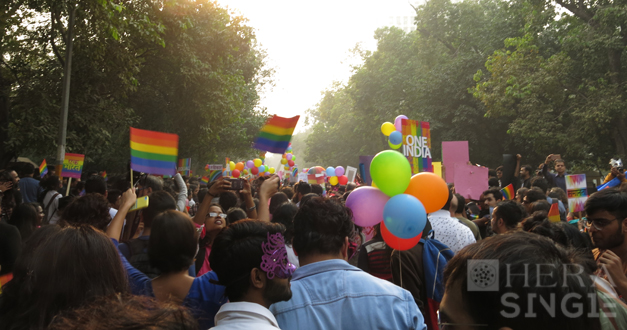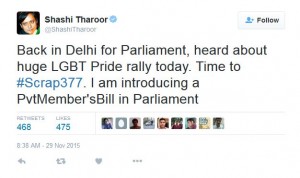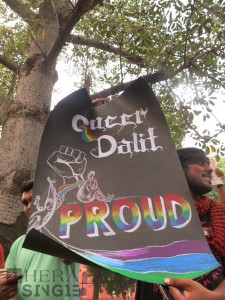
On November 29th 2015 the LGBTQ community celebrated Delhi’s 8th annual Queer Pride march. This year’s pride addressed intersectionality and recent discussions on minority rights.
On November 29th 2015 the LGBTQ (Lesbian, Gay, Bisexual, Trans, Queer identified) community and its supporters took to the streets of central Delhi in the city’s 8th annual Queer Pride march. The dancing, chanting and singing crowd made their way from Barakhamba Road to Jantar Mantar, Delhi’s officially designated protest area. With a substantial turnout the march not only celebrated queer pride but expressed a pressing demand for the acknowledgement of gender and sexual diversity. This essay examines the movement’s emerging politics and situates them within India’s fraught socio-political landscape.
In previous years, the demand to abolish Article 377 of the Indian Penal Code took centre stage at the pride. This law – a leftover of the anti-sodomy legislation from British colonial rule outlawing “acts of carnal intercourse against the order of nature” – can effectively be used to criminalize homosexuals. The queer movement has received some tentative support from politicians in the run up to the parade, as finance minister Arun Jaitley spoke out against the 2013 Supreme Court of India decision to uphold Article 377. Shashi Tharoor member of parliament in India’s Congress party also pledged his support tweeting that he had submitted a private members’ bill to scrap the Article. Yet, both parties’ support seems fickle with the ruling Bharatiya Janata Party’s (BJP) commitment especially in doubt over statements made by senior party members likening homosexuality to a genetic disease or a western import preying on Indian culture. With little groundswell support at the parties’ political base, a repeal may struggle in the country’s parliament, the Lok Sabha. The movement’s hope is therefore pinned on a curative petition to the Supreme Court to reconsider its ruling and invalidate article 377.

Congress member Shashi Tharoor tweets his support for the LGBTQ movement.

A banner at the Delhi queer pride addresses the marginalization faced by different caste identities.
In a city, in which women and queer people routinely feel vulnerable to harassment, the officially approved protest paradoxically offered a relatively safe space to critique the conservative tenor of the current government. Indeed among the sea of rainbow coloured banners and balloons many messages could be spotted explicitly attacking the BJP government and responding to the controversial issue of beef consumption which has recently prompted attacks on Muslim and lower caste communities. In a tense political climate the demand for social acceptance and equal citizenship voiced by the queer community seemingly encountered an even larger conversation about marginalization in Indian society. Beyond the legal issue of queer rights this year’s pride organisers and participants evidently felt compelled to deepen their engagement with intersectionality and the ongoing discrimination faced by religious minorities and caste identities within and beyond the queer community. At a time of shrinking avenues of dissent the pride revealed a movement still largely dominated by middle and upper middle class sections of the society, yet increasingly determined to address the hegemony of dominant caste and class politics, ultimately proving the urgency of its cause: a celebration of difference in the face of a general assault on diversity and multiplicity.
Scenes of the Delhi Queer Pride 2015
All photos photographed by Lucie Bernroider 2015.